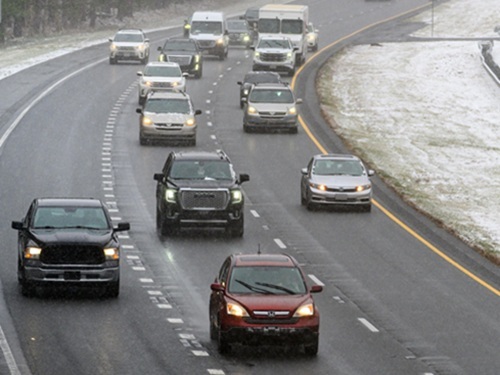A new study from the Insurance Institute for Highway Safety argues that equipping light delivery vans with four specific safety technologies could prevent or mitigate close to four out of 10 fatal crashes involving such vehicles.
[Above photo USPS]
Using federal crash data from 2016 to 2021, IIHS researchers estimated that equipping every light van on the road with front crash prevention, lane departure prevention, blind spot detection, and intelligent speed assistance or ISA technology could address 26 percent of all police-reported crashes, 22 percent of injury crashes and 37 percent of fatal crashes involving such vehicles.

“Equipping delivery vans with these technologies would deliver big safety benefits,” noted David Harkey, president of IIHS, in a statement. “These vehicles are growing rapidly in number and are more dangerous to other road users because of their large size.”
The research firm noted that the recent boom e-commerce, accelerated when the COVID-19 pandemic put home delivery services “into overdrive,” prompted a 43 percent increase in sales of light vans; adding thousands of light vans to the U.S. fleet. About 500,000 light vans — models with a gross vehicle weight rating below 10,000 pounds such as the Ford Transit, Ram ProMaster, and Mercedes-Benz Sprinter — are sold every year in the U.S., according to data gathered by Wards Intelligence.
IIHS said in its report the “increasing prevalence” of those vans on U.S. roads is creating a “safety concern” as such larger vehicles are more likely to cause injuries in crashes with smaller vehicles because of their greater mass. They’re also more likely than passenger cars to kill or seriously injure pedestrians, the firm noted, as their ride height and the shape of their front ends means they strike higher on the pedestrian’s body.
For the study on the potential benefits of equipping light vans with advanced safety features, IIHS said its researchers sifted through police-reported crashes, injury crashes and fatal crashes, looking for those that could be addressed by each feature — for example, rear-end, pedestrian, and bicyclist crashes for front crash prevention and side-swipe crashes for blind spot detection.
ISA, a newer and lesser-known feature, uses a camera or GPS system to identify the speed limit and either warn the driver to slow down or limit power to the engine to keep the vehicle within the legal limit. For this feature, the researchers counted crashes in which law enforcement identified a light van as speeding.

IIHS data analysis found that light vans were involved in an average of 935,371 police-reported crashes, 98,110 injury crashes and 3,637 fatal crashes each year of the study period. Front crash prevention applied to the largest number of these crashes; 17 percent of the total and about a fifth of the fatal incidents. Lane departure prevention applied to 2 percent of crashes overall and 11 percent of fatal crashes. Blind spot detection applied to 4 percent of the total crashes but few fatal ones, and ISA applied to 4 percent of all crash involvements and 10 percent of the fatal crashes.
Notably, those percentages represent crashes that could be prevented or mitigated if every light van on the road was equipped with the features and if the features worked perfectly all the time. In reality, none of those features are completely foolproof, IIHS emphasized – adding that, even with a serious regulatory “push” to install them in all new light vans, it will be decades before all the older, unequipped vans disappear from the fleet.
IIHS research shows that crash avoidance features are already highly effective, and further advancements promise to make them work better.
For example, a 2022 IIHS study showed that front crash prevention systems with automatic emergency braking or AEB systems reduce police-reported rear-end crashes by half for passenger vehicles.
For light vans, similar effectiveness would mean eliminating some 77,000 crashes per year. Pedestrian-focused AEB systems, which IIHS research shows cuts pedestrian crash risk by 27 percent, could eliminate 1,200 light van crashes with pedestrians.
In a related effort, the National Highway Traffic Safety Administration recently finalized a new Federal Motor Vehicle Safety Standard that mandates automatic emergency braking or AEB technology for all passenger cars and light trucks by September 2029.
NHTSA expects this new standard – FMVSS No. 127 – should significantly reduce rear-end and pedestrian crashes, plus save at least 360 lives a year and prevent at least 24,000 injuries annually.
The agency said AEB systems use sensors to detect when a vehicle is close to crashing into a vehicle or pedestrian in front of them and automatically applies the brakes if the driver has not done so.
The new standard applies to nearly all U.S. light vehicles with a gross vehicle weight rating of 10,000 pounds or less. It requires all cars and light trucks in that category to be able to stop and avoid contact with a vehicle in front of them up to 62 miles per hour, with those systems also required to detect pedestrians in both daylight and darkness, NHTSA said.
 Nation
Nation
Registration Open for AASHTO’s Winter Rail Meeting
December 19, 2025 Nation
Nation

